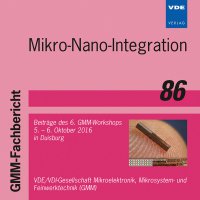Influence of Traps on the Characteristics of ZnO Nanoparticles Thin-Film Transistors
Conference: Mikro-Nano-Integration - 6. GMM-Workshop
10/05/2016 - 10/06/2016 at Duisburg, Deutschland
Proceedings: Mikro-Nano-Integration
Pages: 6Language: englishTyp: PDF
Personal VDE Members are entitled to a 10% discount on this title
Authors:
Vidor, Fabio F.; Meyers, Thorsten; Hilleringmann, Ulrich (Paderborn University, Sensor Technology Department, Paderborn, Germany)
Wirth, Gilson I. (UFRGS, Microelectronic Department, Porto Alegre, Brazil)
Abstract:
Driven by the Internet of Things (IoT) the scientific community and several companies focus on the development of innovative products. Along with large-area applications as flexible displays, the integration of RFID-tags and of sensor systems in textiles for smart clothing are also part of current research efforts. Thin-film transistors (TFTs) serve as basic elements of this technology acting as current modulating elements. To establish a competitive product in the market the development of cost efficient integration processes are required. Therefore, the use of nanoparticle dispersions is a good approach, as they can be purchased at low price and they are applicable on large areas. The use of nanoparticulate ZnO as active semiconductor, for instance, requires adaptations to the integration process. The large surface area of nanocompounds interacts with the ambient inducing instabilities to the transistor operation, hence a stabilization process is necessary. Moreover, the charge carrier flow through the ZnO nanoparticle network occurs along percolation paths. Both mentioned effects are influenced by traps within the ZnO-thin-film. In this article, we discuss the interaction of oxygen and water molecules with the ZnO nanoparticles as well as the effect of active traps in the ZnO network. Its influence on the electrical characteristics of different ZnO TFT device setups is analyzed.


